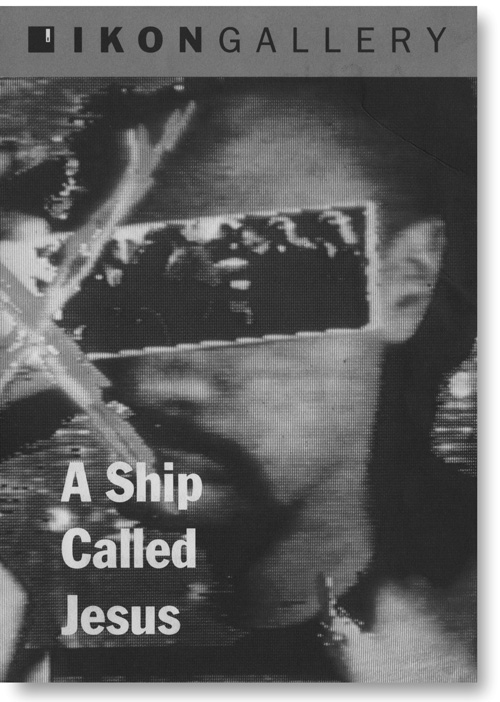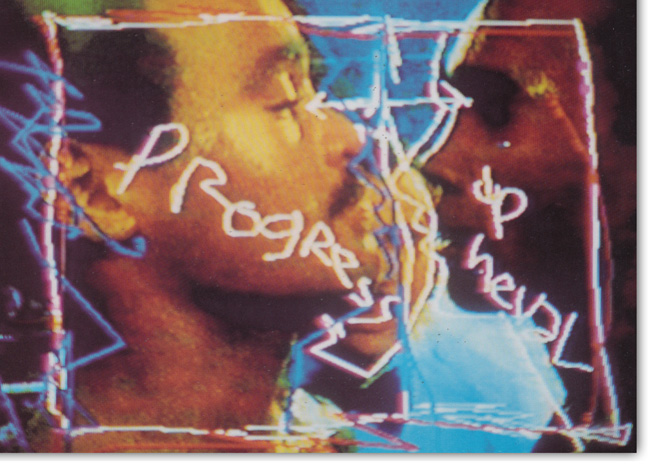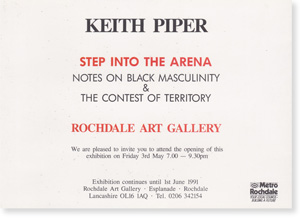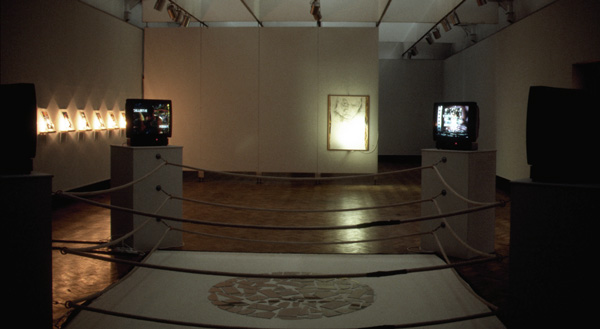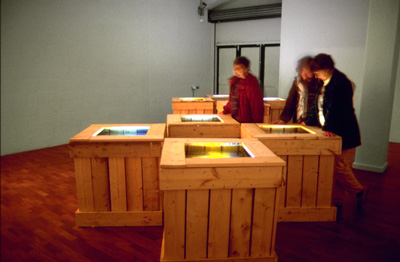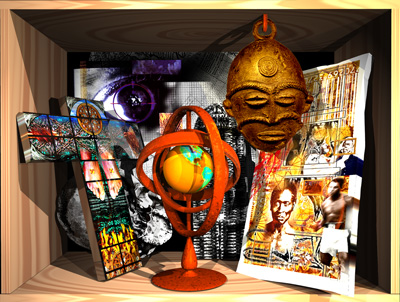a Glitched Practice (pt-2)
Notes on the Research and Development of a multi-channel video project as part of Jet-Black Futures.
Following a few experimental forays into the use of the Amiga as an art making tool during the late 1980s, the first substantial body of my work to extensively explore Amiga montage visuals was ‘A Ship Called Jesus’, a solo exhibition that took place at the Ikon Gallery, Birmingham in January 1991.
However, it was another solo exhibition, taking place in May of the same year, which is of particular interest here. The exhibition entitled ‘Step into the Arena: Notes on Black Masculinity and the Contest of Territory’, taking place a Rochdale Art Gallery was accompanied by a publication and artist essay exploring themes around ‘Black Art’, “masculinities’ and ‘questions of gender’.
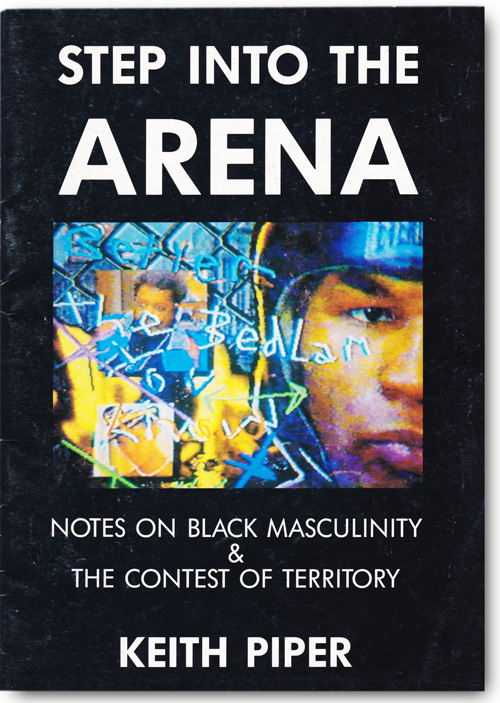
‘Step into the Arena’ Exhibition Publication. Text by Keith Piper. Published by Rochdale Art Gallery. May 1991
In this context, what interests me most about this exhibition is its use of digitised imagery lifted from mainstream culture and montaged using the paint-box tools available through the Amiga computer, alongside its exploration of the aesthetics of the ‘scribble’. Both the image on the front of the catalogue and the invite card, feature crudely haptic, hand scribbled lines and marks electronically inscribed across the surface of the media screen. This is a ‘lifting’ and re-articulation of the ‘trembling twanged line’ from Basquiat, Warhol and Marker into the brash new space of the early digital paint-box.
Four display plinths, each supporting a video monitor with its screen facing into the boxing ring and displayed a video sequence built around a dense montage of images and sounds above a fragmented circle of mirrored glass.
A soundscape featuring the voices of writers and boxing historians such as Joyce Carol Oates and Budd Schulberg, vying with a repeating sonic rift and collage of sampled sounds filled the gallery space. The visuals for this work represent an early, but also extreme example of a visual production style that I would reuse in work across the decade. This would feature a dense mix of images, texts, symbols and textures mixed and remixed between an Amiga computer and various video sources, through a video ‘mixing desk’. The output from this desk would be recorded in real time, with the final video being the result of the performative interplay of mixing between sources in time to a sonic beat (rather like the ‘live’ performative action of a VJ(video jockey) within contemporaneous club cultures ).
What is more marked in this video when compared to others from this period, is the use of the animated drawn lines, scribbles and ‘rotoscoped’ outlines as a core part of the visual collage. This revisits once again the notion of the ‘twanged line’ in an aesthetic device which would resurface later during the 1990s.
Step into the Arena. Extract from Amiga Montage Video. May 1991 |
||
My use of the Amiga would consolidate across the early 1990s, with key works such as ‘Tagging the Other’ and ‘Trade Winds’, both from 1992, being examples of multiscreen installations with animated Amiga montage at their core.
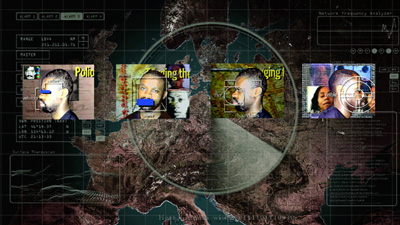
Surveillance: Tagging the Other (1992)
Mixed media installation with 4 video monitors,projection and sound
Over this period I replaced my Amiga 500 (A500) first with an A2000 and then an A3000. However, by the early-mid 1990s, Commodore was struggling, and finally filed for bankruptcy in April 1994, consigning the Amiga to computer history. By this period however, Apple Macintosh computers were becoming more affordable and video-friendly, and I incrementally shifted my production towards this alternative platform.
My final heavily Amiga-reliant work was ‘Go West Young Man’ completed in 1996. This work assembled passages of Amiga montaged animation onto a video editing timeline on an Apple Macintosh computer.
Go West Young Man (1996). 3mins 50seconds. Amiga Montaged Animation. |
|
Club Mix
In 1996, commissioned by, and in collaboration with InIVA, (The Institute of International Visual Art), I engaged on an ambitious project composed of multiple elements entitled ‘Relocating the Remains’. Proposed initially as a ‘mid-career retrospective’, the project became more of a re-engagement with a number of core themes that had punctuated my practice, using the new tools of interactive multimedia to repackage and represent a number of past projects as interactive installations, and as ‘virtual’ spaces within an interactive CD-Rom.
Another element of this project went under the title of ‘Club Mix’. Echoing the ‘in-studio’ use of the video mixing desk in works such as ‘Step into the Arena’, it was proposed that these acts of visual ‘mixing’, could be performed ‘live’ in a club setting. This was a moment in which VJ culture, the mixing of projected visuals live and in sympathy with the sonic/musical/rhythmic space of the dance floor, had become a common visual element of club culture.
More visual than conceptual, this gave me the space to generate a series of short visual collages which could be loaded and mixed live in club spaces wherever the main exhibition was staged. This gave me a context to dip back into some of the more spontaneous uses of the animated scribble, the rotoscoped line and the blurring shuddering ‘trembling’ image which I had explored during the early 1990s, using a combination of jagged pixelated Amiga graphics with the more sophisticated video montage tools found in applications such as ‘After Effects’ on the Apple Mac.
Relocating the Remains: Club Mix. 1997-1999 (Random Extracts) |
|
The aesthetics of the hand drawn line largely disappeared from my practice during the early 2000s, but a number of video works from 2017 onwards began to re-explore this device using Apple Macintosh based applications, (in this case ‘Adobe Photoshop’ as an animation platform).
The three channel video installation, 'Unearthing the Banker’s Bones' (2017) contained some peripheral experimentation with the scribbles and hand drawn textures. However it was the single channel video work ‘Mic Drop’ of September 2017 that was to extensively re-engage with the diagrammatic story-telling possibilities of the roughly hand rendered line, as seen in the following extract.
Extract from 'Mic Drop' 2017 |
||
In the next post I will return to a direct discussion of the development of the current work ‘In Search of Four Horses’ in relationship to this longer history of practice.

